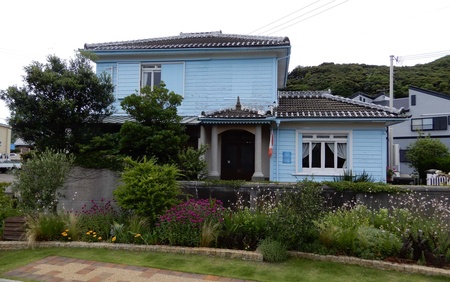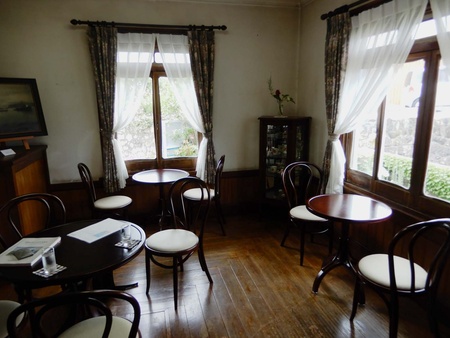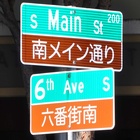If you head towards the Kii Peninsula along the coastline from Ago Bay in Mie Prefecture, you will arrive at Kushimoto Town, the southernmost town on the main island of Honshu. In my previous article, I wrote about how men used to come from here to harvest pearl oysters (white pearl oysters) near Thursday Island in Australia, but there is another town along the coast further ahead where you can still find traces of people who were involved with overseas countries in the past. This is Mihama Town, which is located at the westernmost tip of the Kii Peninsula and includes Cape Hinomisaki.
From Kushimoto Town, we head north along the western coastline of the Kii Peninsula. We will be driving on National Route 42 all the way, but to go along the coast, we will switch to the Gobo-Yura Prefectural Route in Gobo City. This is Mihama Town, and as we head towards Hinosaki, there is a bus stop along the road with a sign saying "Amerikamura."
Although it sounds like a name you might find in a tourist spot, it is actually based on a long history that makes it worthy of such a name. In the area called Mio (formerly Mio Village), where the bus stop is located, people flocked to Canada during the Meiji period, and many of them later returned to Japan, which is why it came to be called America Village.
From an interview 32 years ago
I visited this area 32 years ago for an article. As part of a series of reports on small happenings in Japan's seaside areas, I followed the history and present of the Mio area. Some people who had migrated to Canada during the Meiji era were successful and returned home, building Western-style houses to live in. These houses remain in the area, giving a sense of the prosperity of the time. However, like other depopulated areas in Japan, the population is declining, vacant houses are increasing, and the future survival of the local elementary school is in doubt.
So the locals started a campaign to attract young families with children from outside by renting out vacant houses, including these, at low prices. This idea was featured in the newspapers under the headline "Why not move to America-mura?" and caused quite a stir.
The area, which once sent out many immigrants overseas, gradually shrunk over time due to depopulation, and as a last resort, they started to recruit immigrants from within the country. Meanwhile, the community of Mio immigrants to Canada seems to have grown to be more cohesive than their hometown. This is the story I compiled during my visit to Americamura.
During the interview, Shigeharu Koyama (78 years old at the time), who was a thorough researcher of local immigrants in Mio, guided me around the area and gave me a detailed explanation of the immigrants from Mio. At Hozenji, a Jodo sect temple on a hill in the center of the area, there were a number of plaques bearing donations from the immigrants' hometowns, such as "Vancouver / 5,000 yen / ...". In addition, I noticed some houses that had their entrances and windows blocked up, and were clearly vacant.
"This is the home of someone who went to Toronto for 50 years. This is the home of someone who went to Alberta, Canada," said Koyama, who seemed to know the circumstances of all the houses. Among these houses, we were guided to a house that is a symbol of America-mura. It was a two-story house with a blue-gray exterior and a tiled roof that was a mix of Japanese and Western styles, and was used as a residence at the time.
I was also able to talk to some people who had immigrated to Canada. One of them, Ei Hashimoto (87 years old at the time), came to Canada at the age of 17 and returned to Japan after the war. "There was no place more comfortable to live than the fishing towns in Canada," he said, and he had a strong attachment to Canada.
At Hinosaki, away from the center, there is the "Amerikamura Museum," which recreates the history and lives of people who came to Canada. This museum was operated by Nankai Bus Co., Ltd., which had been trying to develop the surrounding area since the 1950s. The "Amerikamura"-like things were also used as a tourist resource.
Salmon fishing invites visitors to Canada
Immigration from Mio began with one man. A carpenter named Kuno Gihei, who was born in Mio village in 1854 (Ansei 1), learned from his cousin, who was a crew member on a cargo ship bound for Canada, that Canada had promising fishing and agricultural prospects. In 1887 (Meiji 20), he boarded a ship from Yokohama and traveled via Vancouver to the fishing town of Stibston.
Mio village is surrounded by mountains, has a small amount of arable land, and the fishing industry is sluggish due to competition for fishing grounds. In addition, the villagers suffer frequent typhoon damage and live in extreme poverty. Gihei, who left his hometown, was amazed to see a large school of salmon on the Fraser River near Vancouver, and wrote a letter to his hometown saying that fishing there could help save the struggling village of Mio.
There were already Japanese people engaged in salmon fishing on the Fraser River, and upon hearing this news, the villagers of Mio started to emigrate to Canada one after another. In 1900 (Meiji 33), the Canadian Mio Village Association was formed. Immigration peaked during the Taisho era, and in response, the lives of the people of Mio became more prosperous as they received remittances from Canada. However, when the Pacific War began, all Japanese people were forced to move and were put into internment camps.
When the war ended, the repatriation to Japan began. Over 300 people returned to Mio. However, most of them were disappointed with the poor living conditions in their hometown after the war and went back to Canada. With this mutual travel as a backdrop, a cross-border organization called the Mio Canada Liaison Council was born.
According to Yamamoto, Mio was called America-mura (American Village) in the early Taisho period. Not only did it send a large number of immigrants to the American continent, but many people returned to Mio and adopted an American lifestyle. Even the elderly wore bright checked shirts and spoke a mixture of English.
These historical facts, of course, remain unchanged, but the town itself has naturally changed since then, and so have efforts to preserve and record its history.
A private house turned into a Canadian museum
First, the local Mio Elementary School, whose survival was in doubt, was closed in 2008. In addition, the America-mura Museum (later the America-mura Canada Museum), operated by Nankai Bus, had also already closed.
Meanwhile, the iconic blue-gray exterior of America-mura has been transformed into the refreshing light blue "Canadian Museum." The house was built in 1933 by a person who had immigrated to Canada and returned to Japan, and was later purchased and lived in by Canadian-born Noda Hideo, who has roots in Mio. However, it eventually became vacant and was donated to the local town of Mihama, and since 2018 it has been used as a museum and cafe under the management of the nonprofit organization Hinomisaki America-mura.
The house is a two-story wooden structure with clapboard exterior and a hipped roof covered with Western tiles. The rooms are a mix of Western and Japanese-style. The unusual feature is the basement, where the toilet is a seated toilet.
Inside the building, there are exhibits on the history of immigration from Mio, as well as everyday items brought back from Canada by immigrants. There is also a cafe on the first floor where you can relax and reflect on the history of immigration. Takae Mio, the museum's director, says, "The history of the region will not be preserved unless we actively try to preserve it. It is meaningful to keep this building as a living witness to Mio's immigration to Canada."
Thirty-two years ago, when I visited Mio, I encountered a Japanese couple who had roots in Mio and were living in the United States. They had come to Mio from the United States with their daughter, daughter-in-law, and grandchildren, making it three generations of the family. This family has a deep attachment to Japan, and perhaps now they have a fourth generation child who will visit Mio again.
In fact, people still come to Mio from Canada and other places to search for or visit their roots. The flow of people who once left this small village for overseas travel eventually returned and created Americamura, and it seems that this flow continues in a different form to this day.
(Some titles omitted)
© 2023 Ryusuke Kawai









